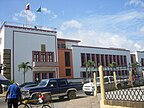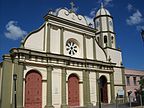Guanare
| Guanare | ||||||
|---|---|---|---|---|---|---|
| City | ||||||
| Guanare | ||||||
|
||||||
|
||||||
| Coordinates: 9°02′37″N 69°44′56″W / 9.04361°N 69.74889°WCoordinates: 9°02′37″N 69°44′56″W / 9.04361°N 69.74889°W | ||||||
| Country |
|
|||||
| State |
|
|||||
| Founded | 3 November 1591 | |||||
| Area | ||||||
| • Total | 2,008 km2 (775 sq mi) | |||||
| Elevation | 183 m (600 ft) | |||||
| Population (2008) | ||||||
| • Total | 235,201 | |||||
| • Density | 100.63/km2 (260.6/sq mi) | |||||
| • Demonym | Guanareño(a) | |||||
| Time zone | VST (UTC-4:30) | |||||
| • Summer (DST) | not observed (UTC-4:30) | |||||
| Postal code | 3350 | |||||
| Area code(s) | 0257 | |||||
| Website | Alcaldía de Guanare (Spanish) | |||||
| The area and population figures are for the municipality | ||||||
Guanare (Spanish pronunciation: [ɡwaˈnaɾe]) is the capital and most populated city of Portuguesa State, Venezuela. It is where la Virgen de Coromoto is said to have appeared to a Coromoto Indian.
Guanare was founded November 3, 1591 by Juan Fernández de León. Located at the edge of the Southwestern floodplains, near the Andes foothills, Guanare is in a region known for livestock and agricultural production. Guanare is also the location of one of the campuses of UNELLEZ [1], one of the nation's main agricultural universities.
It is also said that is the spiritual capital of Venezuela, and it is recognizable for its tourism, and where many events take place.
...
Wikipedia






